The winner of a chess game is the player that makes fewer wrong moves then his opponent
In this issue I will present my game played recently on Playchess.com. I didn't play rated game for a long time so I decided to play against weaker opponent. As you'll see I played so badly for my rating but the game was decided by greater number of errors my opponent did.[Event "Rated game, 30m + 0s"]
[Site "Main Playing Hall"]
[Date "2006.08.18"]
[Round "?"]
[White "Ciprian"]
[Black "Ibarix"]
[Result "0-1"]
[ECO "C50"]
[WhiteElo "1478"]
[Annotator "Fritz 9 (60s)"]
[PlyCount "152"]
[EventDate "2006.08.18"]
{C50: Hungarian Defence and Giuoco Pianissimo} 1. e4 e5 2. Nf3 Nc6 3. Bc4 Bc5
In earlier posts I said I don't quite know openings. I recently started to study ideas for some openings (Giuoco Piano). It's incredible that I'm quite strong player but have no clue about basic ideas in most of the openings. So I took advice from some of the internet sites and began with Giuoco Piano just as junior players start with it in their chess lives. After these moves white developed 2 pieces, took some share of the center with e4 and cleared way for a short castle. White bishop is eyeing the f7 square which is the weakest point at the start of the game just as white's f2. Why? Because at the beginning it's defended only once - by the king. The main point for black's good chances is central break d5 and Nf6. White has several possibilities in this position.
1. b4 - the Evans gambit
2. c3 - preparing for d4 thrust or playing Modern Italian c3, d3 and after that d4 maybe
3. d3 - leading either to Giuoco Pianissimo after white's Nc3, 0-0 and black's d6, Nf6 and 0-0 or Modern Italian
4. d4 immediately, the Italian Gambit
5. 0-0 weak line according to some authors
6. (read misc. instead of six because this is not quite the option for white) Bxf7+ ??????? Jerome gambit, it doesn't work, don't ever play it. Well, as much as I investigated no one said anything about Ng5 for white at move 5. So that's probably not fast enough for white and not the main line. I know from earlier the Fried Liver Attack (Ng5 in fourth move attacking f7). You usually respond with 4...d5, white takes with 5.exd5, you move your knight and attack the bishop with 5...Na5 etc. You can check it out for youself.
4. Nc3 Nf6 5. Ng5
Here my opponent played Ng5. I started with opening study after this game so I didn't know what the main line is or what are the good moves in Giuoco Piano. Apparently, my opponent didn't know it neither. I don't think he knows the theory and leaves the book so early because his rating suggests it. Obviously, white is threatening f7 so I should do something about it. 5... d5 and 5... 0-0 come to my mind but I thought that I would have better pawn structure after 0-0.
5... O-O
Here white has the option of exchanging his knight and bishop for black's rook and pawn at f7 and it should be pretty equal.
6. O-O
In this position I had to play d6 and Bg4 or something like that but I chose a move I don't even know why I played it. I noticed I'm playing first 15 moves automatically without giving much tought to the position. This could be a potential weakness that I should correct as soon as possible.
6... a6 {Covers b5}
Here are some of the games Fritz found.
(6... Nd4 7. d3 c6 8. a3 a6 9. b4 Ba7 10. Bb2 d5 11. Ba2 Bg4 12. Qd2 Nh5 13. exd5 Nf4 14. Nge4 cxd5 15. Ng3 Bf3 16. Qe3 Nde2+ 17. Ncxe2 Bxe3 18. gxf3 Qg5 19. Rae1 Bd2 20. Rd1 Nxe2+ 21. Kh1 {Mac Connell,L-Eriksson,A/Szombathely 1993/TD/0-1 (46)})
(6... Bb4 7. Re1 Bxc3 8. dxc3 d6 9. h3 h6 10. Nxf7 Rxf7 11. Bxf7+ Kxf7 12. b3 Kg8 13. Qf3 Qe8 14. Qg3 Nh5 15. Qf3 Qf7 16. Qxf7+ Kxf7 17. g4 Nf6 18. f3 Bd7 19. b4 d5 20. Bb2 d4 21. cxd4
{Giardina,C-Wohde,J/Germany 1988/GER/1/2-1/2 (42)})
7. Nd5 (7. d3 d6 =)
I should take the knight, right? Right. That simple. Taking the knight doen't create weaknesses.
7... Nxd5 8. Bxd5
In this poition I should play Qf6 as Fritz is suggesting. Playing Qf6 before white plays Qf3 secures black pawn structure's healthy. But I played very weak move.
8... Bb6 ?? {a transit from better to worse}
After the game I looked at this move scratching my head asking - What the heck is this move doing?
(8... Qf6 =) 9. Nxh7 (9. Qh5 {ends the debate} h6 10. Nxf7 Rxf7 11. Qxf7+ Kh7
12. d3 +-)
Fortunately, white didn't see Qh5. He played knight sacrifice in a gambit style. And the best way to refute the gambit is by accepting it. :)
9... Kxh7 -+ 10. Qh5+ Kg8 11. d3
Here I should play simple d6 and free up my bishop but instead I played a move that is horrific. It's not so bad but in the light of my improvement this is not good. Weaker opponents can't utilize your weaknesses because they are - weaker. But against stronger opponent I would have a hard time so I have to reduce the number of these kind of moves. I feel like my concentration is oscilating.
11... Qf6 (11... d6 12. c3 -+) 12. Bg5
Of course, 12... Qg6 would be a disaster. Why? Well, my pawn at f7 can't move because it's pinned by white's bishop so g6 is practically not guarded. Moving pieces to g6 would hang them just like 12... Qg6 does hang the queen. White can gain enormous advantage with 13. Qxg6.
12... g6
If I was white and playing against unrated opponent I would play 13. Qh4 and if that player is not strong and plays i.e. Qd6, Bf6 could even and the story or seal the fate of black's queen. Qh4 is suggested by Fritz too. Besides, I'm up an exchange so white shouldn't exchange pieces but pawns if he wishes to draw the game. Or he can ask for a draw politely. :)
13. Bxf6 (13. Qh4 !? Qg7 14. Kh1 -/+)
Any move besides gxh5 gets you mated.
13... gxh5 14. Bxc6 bxc6
The old saying goes - always take towards the center. Don't take it too serious tough. If taking towards the center gets you mated.... well, you shouldn't take towards the center. There are rules but there are exceptions to all of them.
15. Bxe5 d6 16. Bf6
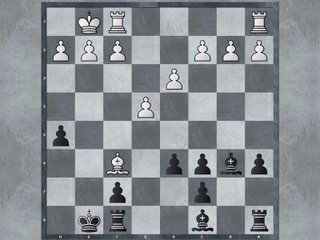
16... Be6 17. Rfe1 {White prepares e5}
Interesting, Fritz suggests one of the rooks to b8 or e8 and after that Kh7 whih I played. I tought it would be nice to maybe line up the rooks on the opened g file.
17... Kh7 18. e5
Of course, I won't take the pawn and solve the tension in the middle. I'll pass that oportunity. If instead white takes then I don't have any doubled pawns.
18... Rg8 19. Bh4 ? (19. c3 Kg6 -+) 19... Bd4 (19... Rg4 !? {seems even better} 20. g3 Rag8 21. Re4 -+)
20. exd6
I must say I didn't expect this but it's good for me. Now I won't have doubled pawns any more.
20... cxd6 21. c3
My bishop is attacked and I have to move it away. I wanted to aim at f2 so I left the bishop on g1-a7 diagonal.
21... Bb6 22. Be7
I'm not affraid of this so called threat because white's pawn on d-file is not defended and I can win it back if white takes my pawn.
22... Ra7 23. Bf6
Here I wanted to provoke white's pawns and put them on the color of white's bishop. I played...
23... Bh3 24. g3 Rg6 25. Bh4 Re6
I thought exchanging pieces will help me because my king will stop white's extra 2 pawns on kingside and my extra bishop will do some work too. Fortunately, white exchanged.
26. Rxe6 fxe6 27. Re1 ?! {just waiting for the end} (27. Bg5 Rb7 -+)
Fritz suggests Rf7 then Kg6. I played these moves inverted but it's no big deal because everything is defended.
27... Kg6
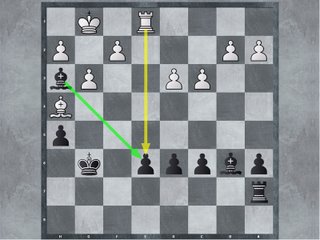
28. Re4 (28. d4 {doesn't improve anything} c5 29. dxc5 Bxc5 -+)
Of course, white can't take on e6 because my bishop defends it from h3.
28... Rf7 29. Rf4 (29. d4 {doesn't get the bull off the ice} c5 30. g4 Bxg4 31. dxc5 Bxc5 -+) 29... Rxf4 30. gxf4
Ok, the rooks are off. This is good for me now. White has doubled pawns on f-file so when I block them I'm up a bishop practically.
30... Kf5 31. Bg3 (31. d4 {doesn't change the outcome of the game} d5 -+) 31... Kg4 (31... d5 {seems even better} 32. b4 -+)
Instead of Kg4 I should have played Bd8 intending h4 and after f3, h4 and the retreat of white's bishop I'm winning f4 pawn.
32. d4 (32. f5 { is no salvation} e5 33. f6 Bd8 -+) 32... h4 (32... d5 {and Black can already relax} 33. a3 -+)
33. f3+
The simple Kxf3 is the best but I don't know why I didn't play it.
33... Kf5 (33... Kxf3 {and the rest is a matter of technique} 34. Bxh4 c5 35. Bf2 cxd4 36. Bxd4 Bxd4+ 37. cxd4 Kxf4 38. Kf2 -+) 34. Bxh4 Kxf4 (34... c5 !? {might be the shorter path} 35. dxc5 Bxc5+ 36. Bf2 Bxf2+ 37. Kxf2 Kxf4 38. b3 -+) 35. Kf2
I decided to push the pawns.
35... e5 36. Bf6 (36. Bg3+ Kf5 37. Ke2 -+)
Notice that white could have lost 3 pawns for my 1 pawn if he didn't do anything about e5.
36... exd4 37. cxd4 Bf5 (37... Be6 {keeps an even firmer grip} 38. b3 -+)
Be6 was better because of Bd5 attacking f3 pawn.
38. Ke2 (38. Bg7 Bb1 39. a3 Kf5 -+) 38... Bb1 39. a4 Bc2 40. a5 (40. Be7 d5 41. Bd6+ Kf5 -+) 40... Bxa5 41. h4 (41. Be7 {doesn't improve anything} Bb4 -+) 41... Bg6 42. Bg5+ Kf5 43. Be7 Bc7 44. Ke3 Ke6 45. Bg5
Now it's time for the second push.
45... c5 (45... Bb6 !? {makes it even easier for Black} 46. Bh6 -+) 46. dxc5 dxc5 47. b3 (47. f4 {does not win a prize} Kf5 -+) 47... Be5 (47... Bc2 {keeps an even firmer grip} 48. h5 -+) 48. f4 (48. Kd2 { cannot undo what has already been done} Bh5 -+) 48... Bf6 (48... Bc3 { and Black can already relax} 49. h5 Bc2 50. Bd8 -+) 49. Bh6 (49. Kd2 { hardly improves anything} a5 -+) 49... Kf7 (49... Bc2 { makes it even easier for Black} 50. h5 -+)
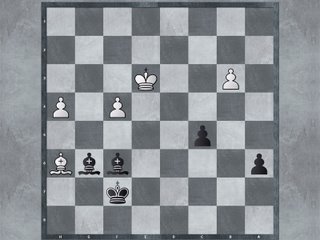
I completely missed h4 pawn was hanging.
50. Kf3 (50. Kd2 { does not save the day} Bxh4 51. f5 Bxf5 -+) 50... Bxh4
But not for long. That pawn was doomed anway.
51. Kg4 Be1 52. f5 Bh7 53. Bg5 (53. Kf3 {doesn't get the bull off the ice} Bxf5 54. Ke2 Bc3 -+)
I need to free up my h7 bishop....
53... Bg8 54. Bd8 (54. Kf3 {doesn't change anything anymore} Bb4 55. Ke4 Ke8 -+)
I'm freein g up my bishop with tempo on white's bishop.
54... Ke8 55. Bb6 (55. Bg5 {doesn't get the cat off the tree} Bxb3 56. Kf3 a5
-+) 55... Bb4
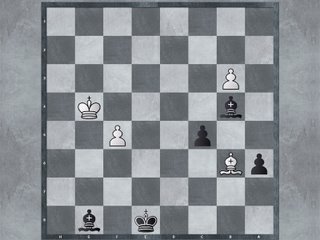
Everything is defended, white pawn on b3 is hanging, I'll take it and then put my king on f2 where it can never be driven away and I'm completely winning. Then I'll push my pawns with help of my strong bishop pair.
56. Kg5 (56. Kf3 {there is nothing better in the position} Bxb3 57. Ke4 -+) 56... Bxb3 57. Kg6 Bc2 (57... a5 !? {seems even better} 58. f6 Bf7+ 59. Kf5 -+) 58. Kf6 c4 59. Be3 c3 60. Ke6 Bb3+ 61. Kf6 c2 (61... a5 62. Bc1 a4 63. Kg5 a3 64. f6 a2 65. Be3 c2 66. Bb6 c1=Q+ 67. Kf5 Qf1+ 68. Kg5 Bd2+ 69. Kh4 Be6 70. f7+ Kxf7 71. Kg3 Bf4+ 72. Kh4 Qh1#) 62. Ke5
Finally, a position I was looking for. f2 is save for my king as white eventually had to move his king in the center of the board. Usually king is better in the center of the board in the endgame but I'm so ahead that I don't even need my king. White can't meet all of my threats at once.
62... Kf7 63. f6 Bc3+ ( 63... a5 64. Ke4 a4 65. Kd3 a3 66. Bb6 c1=Q 67. Ke4 Qc6+ 68. Ke3 Qxb6+ 69. Ke2 Bc4+ 70. Kf3 Qxf6+ 71. Kg4 Be2+ 72. Kg3 Bd6+ 73. Kh3 Qf3+ 74. Kh4 Qg3#) 64. Kf5 a5
I don't need to take the pawn immediately, it's going to fall eventually and a5 is faster. Even faster was Bb2.
65. Bc1 (65. Bb6 {does not help much} Be6+ 66. Ke4 c1=Q 67. Bc7 Qc2+ 68. Kf3 Qf5+ 69. Ke2 Bc4+ 70. Ke3 Bd5 71. Bf4 Qe4+ 72. Kf2 Qe1#)

65... a4 66. Ba3 (66. Ke4 {does not improve anything} Bb4 67. Bh6 a3 68. Bg5 a2 69. Be3 a1=Q 70. Kd3 Qd1+ 71. Ke4 Qd5+ 72. Kf4 Bd6+ 73. Kg4 Kg6 74. Bf4 Qg2+ 75. Kh4 Qf2+ 76. Kh3 Be6#)
My plan is to maneuver bishop to f6 and e7 and then support a3 from there.
66... Bxf6 67. Bc1 (67. Kf4 {doesn't do any good} Be7 68. Bc1 a3 69. Ke5 a2 70. Ke4 a1=Q 71. Be3
Qh1+ 72. Kd3 Qd5+ 73. Ke2 Qd1+ 74. Kf2 Bh4+ 75. Kg2 Qg4+ 76. Kh2 Qg3+ 77. Kh1 Bd5#) 67... Be7 68. Ke4 (68. Kf4 { is not the saving move} a3 69. Bd2 a2 70. Kf5 a1=Q 71. Ke4 Qh1+ 72. Kd4 Qd5+ 73. Ke3 Bg5+ 74. Kf2 Qxd2+ 75. Kg3 Bd5 76. Kg4 Qf4+ 77. Kh5 Bf3#) 68... a3 69. Kd3 (69. Kf3 {a fruitless try to alter the course of the game} a2 70. Bb2 Bd5+ 71. Kf2 a1=Q 72. Bxa1 c1=Q 73. Ke2 Qc2+ 74. Ke3 Bg5+ 75. Kd4 Qc4+ 76. Ke5 Bf6+ 77. Kf5 Qe4#) 69... a2 70. Bb2 (70. Bd2 {cannot change what is in store for ?} a1=Q 71. Ke4 Qh1+ 72. Kd3 Qd5+ 73. Ke3 Bg5+ 74. Kf2 Qxd2+ 75. Kg3 Bd5 76. Kg4 Qf4+ 77. Kh5 Bf3#)
Ok, I have 2 pawns on 2nd rank and bishop is overloaded and can't meet both threats.
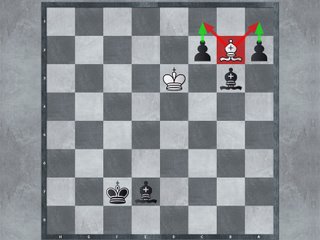
70... a1=Q ! {Decoy: a1.} 71. Bxa1 (71. Bxa1 c1=Q {Decoy}) (71. -- Qxb2 {Mate threat}) 71... c1=Q 72. Bc3 (72. Bf6 {is not much help} Qc4+ 73. Ke3 Bc5+ 74. Bd4 Qxd4+ 75. Kf3 Be6 76. Ke2 Bg4+ 77. Kf1 Qf2#) 72... Qc2+ ( 72... Bg5 73. Ke2 Qc2+ 74. Bd2 Qxd2+ 75. Kf1 Bc4+ 76. Kg1 Be3+ 77. Kh1 Bd5#) 73. Kd4 (73. Ke3 {does not solve anything} Bg5+ 74. Kf3 Bd5+ 75. Kg4 Qg2+ 76. Kf5 Be6+ 77. Ke5 Qd5#) 73... Bf6+ (73... Qf2+ 74. Ke4 Bc2+ 75. Ke5 Qf5+ 76. Kd4 Qe4#) 74. Kc5
The rest is the matter of technique.
74... Qxc3+ 75. Kd6 (75. Kb6 {cannot change destiny} Bd8+ 76. Ka6 Qc7 77. Kb5 Qc4#) 75... Be7+ 76. Kd7 Ba4# 0-1
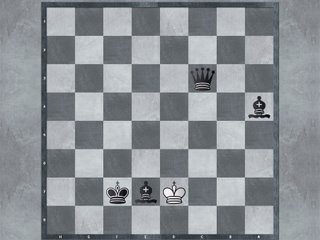
So we've seen that I managed to win just because of experience and because my opponent have done greater number of inaccurate moves then I did. Well, isn't that the case in all games... I started to read some of the books. I never liked books but I got some of them recently and one of them is Rapid Chess Improvement by de la Maza which jumped from cca 1500 rating to 2000+ in 2 years. I got MCO, NCO, Silman's Reasses your chess, Dvoretsky's Opening Preparation and many more. Right now I'm reading Improve Your Opening Play by Chris Ward.
Here you soon...

0 Comments:
Post a Comment
<< Home